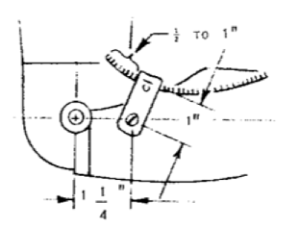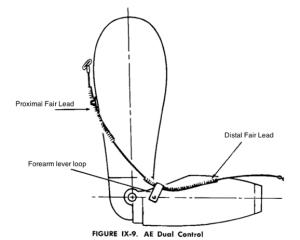16 Transhumeral Prosthesis Project Critique Guidelines
This step-by-step process offers a systematic approach to evaluate the fit and operation of the transhumeral body-powered prosthesis.
To operate both the terminal device and the elbow of a transhumeral prosthesis with a dual-control cable system, the user typically needs approximately 4.5 inches of total cable excursion. The table below outlines the approximate force and displacement required for each component.
| Operation | Force (lbs.) | Displacement (in) |
| Forearm flexion (no load on hook) | 9 | 2-2.5 |
| Prehension, VC hook | 9-35 | 1.5-2” |
| Prehension, VO hook | 10-20 | 1.5 |
| Elbow lock | 2-4 | 1/2-3/4” |
| Upper Limb Prosthetics, Prosthetist’s Supplement, New York University Medical Center |
Control motions refer to the body movements used to operate the components of a prosthesis. The table below provides general estimates of the force and cable excursion a user can generate with each type of body movement.
| Control motions | Force (lbs.) | Excursion capability (in) |
| Glenohumeral flexion | 56 lbs. | 5.3” |
| Protraction | 49 lbs. | 1.6” |
| Glenohumeral extension | ||
| Glenohumeral abduction | ||
| Shoulder depression | 44 lbs. | 1.1” |
| Chest expansion |
Initial location of lift tab: 1¼-1½” distal and 1” anterior to elbow joint center

NYU recommends that the lift tab be approximately 1¼” distal from the elbow center and approximately 1 inch long. In general, the forearm lift tab needs to be close to the axis of rotation in order to minimize excursion required for use, but the closer it gets to the axis the longer the lift tab needs to be in order to reduce the force required.
Depending on the patient’s needs and abilities, adjustments may be made to the distance from the axis and the length of the lift tab.
Initial location of base plate: 25 mm proximal to the distal end of the humerus at the postero-lateral aspect of the mid-humerus.

The baseplate and retainer should be positioned for maximum efficiency for forces transmitted and excursion required. Moving the baseplate more distal and posterior will require less excursion and more force. Moving the baseplate more anterior and lateral will require more excursion and less force.
Two base plates may be used to lead the cable in the smoothest line from the control attachment strap to the lift tab, placing it anterior to the elbow joint center.
***The cable should lie anterior to the elbow joint axis!
